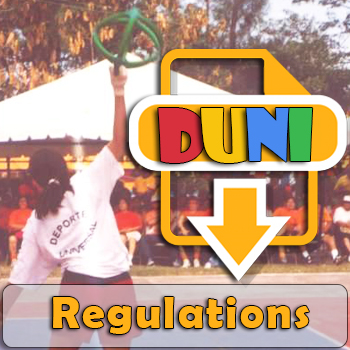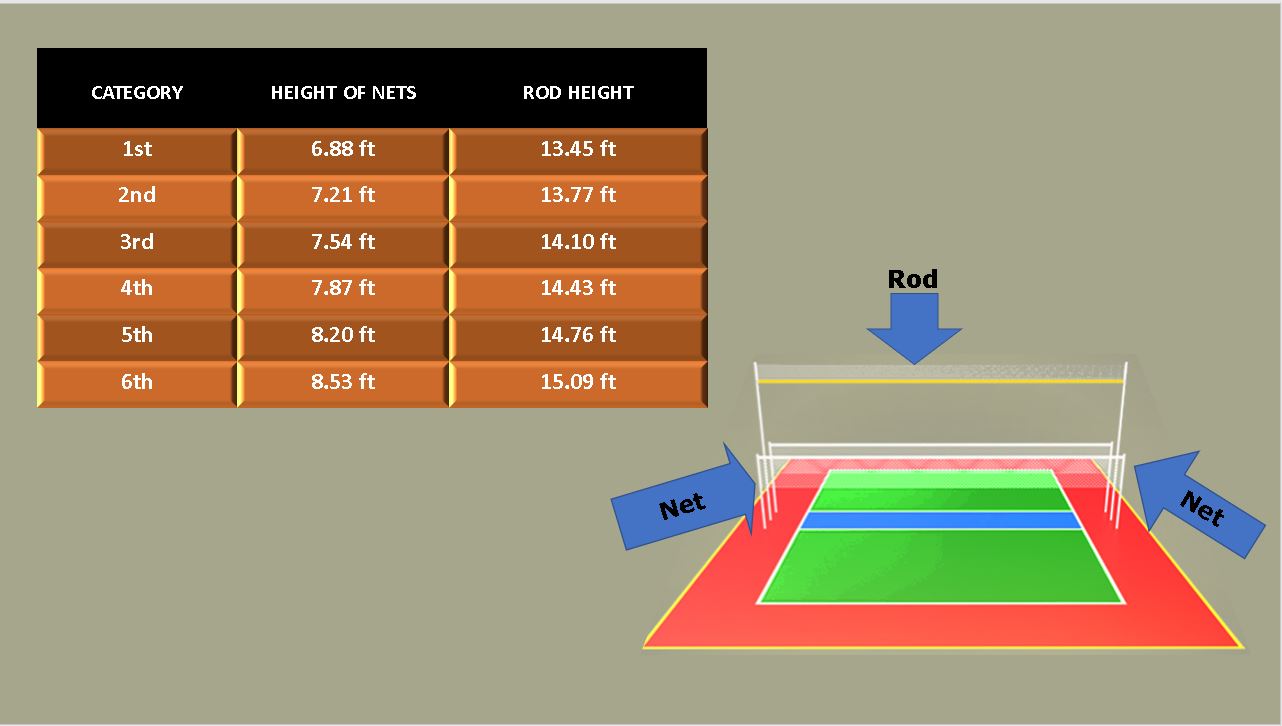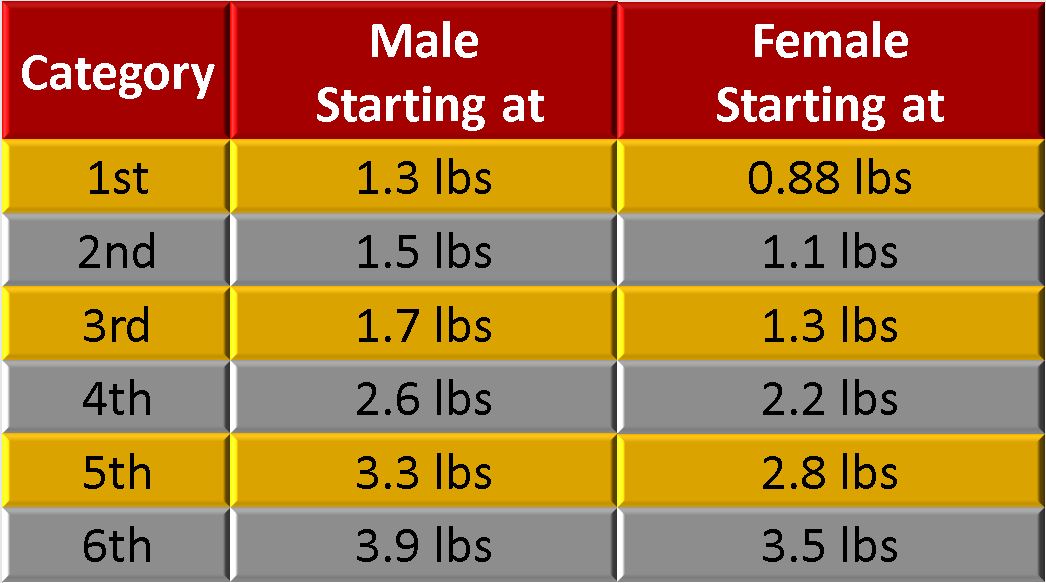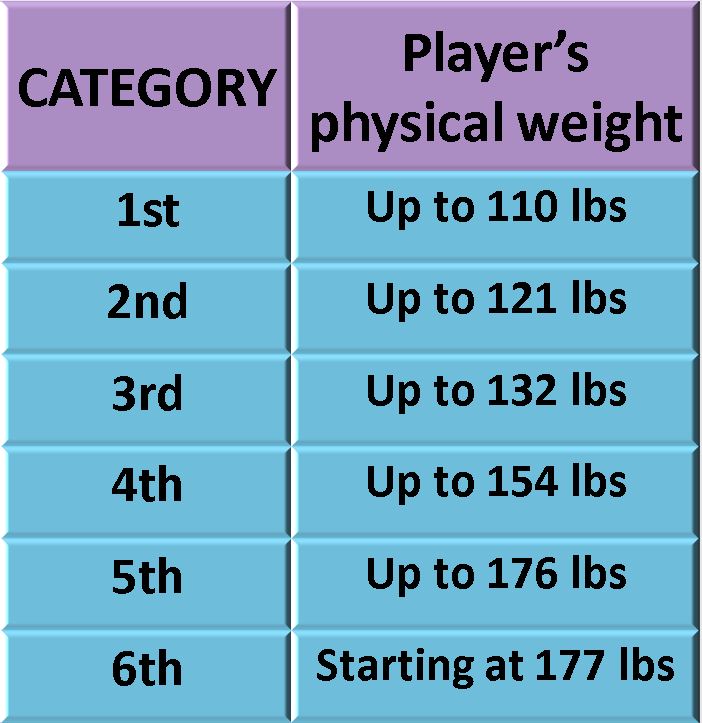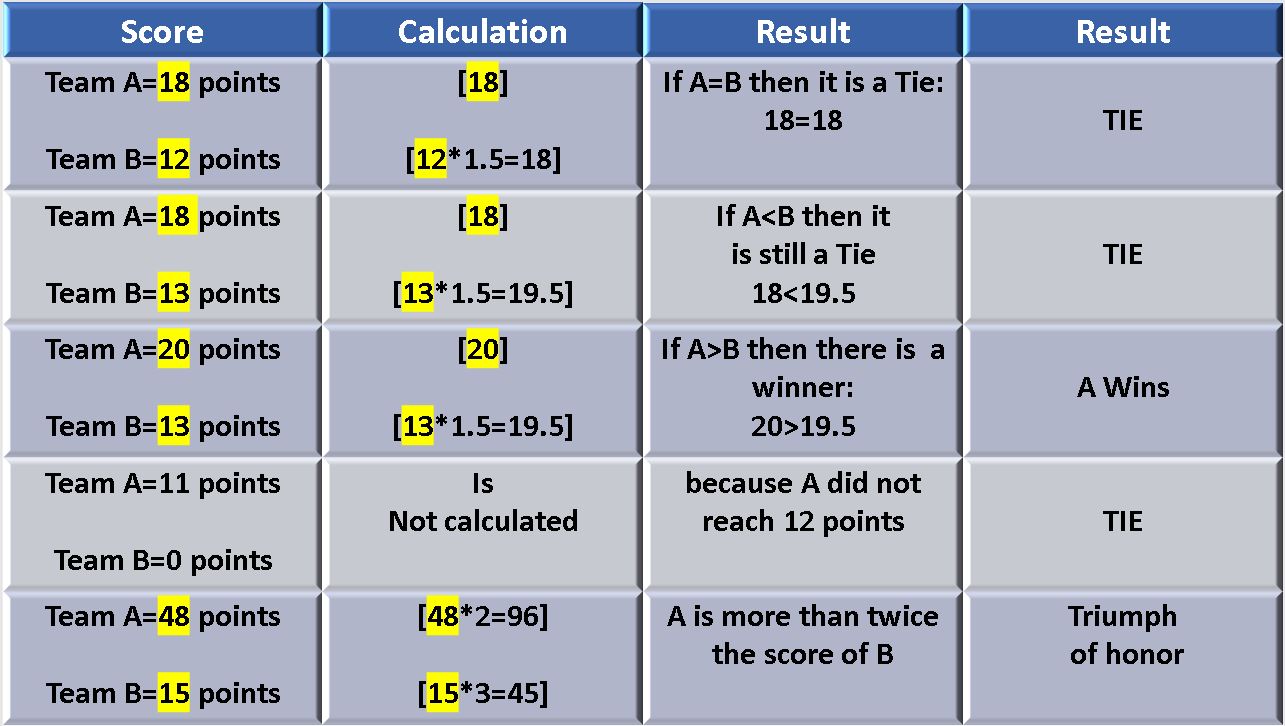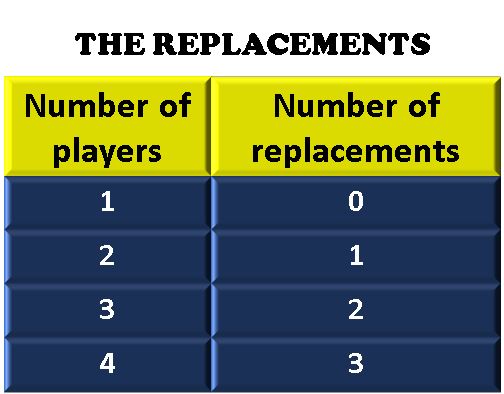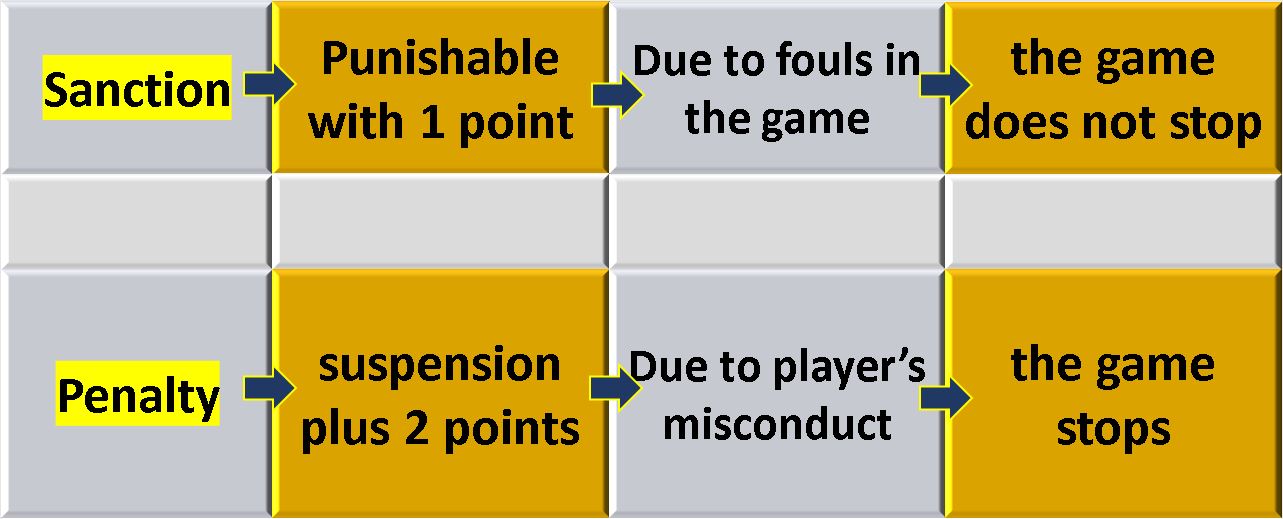The DUNI Regulation Divided into 13 Chapters
CHAPTER 1
THE DUNI COURT
1-. PITCH GROUND:The ground on which the DUNI court is located shall be flat and horizontal, made of grass, wood, asphalt or any other material suitable for the game. It is a fundamental condition that the court is not slippery or too soft.
2-. PITCH SIZE: The surface of the field of play will be rectangular, with dimensions between 6 (six) and 9 (nine) meters wide by 8 (eight) to 13 (thirteen) meters in total length. This total length includes the neutral area, but does not include the safety area.
3-. TYPES OF COURTS: The playing field surface, outdoors or indoors, will meet similar requirements. The height to locate lights or other objects will be at least 2 (two) meters above the rod(s).
4.- PLAYING FIELD: The playing field will be a rectangle formed by white lines. Said rectangle will contain 3 (three) areas, which will be determined by 2 (two) lines parallel to each other and perpendicular to the longest sides of the rectangle that will be called “central lines”.
a.- Therefore, each extreme area of the rectangle will be called “game area”.
b.- The smallest area between these playing areas will be called the “neutral area”.
The width of all the lines that separate the different areas of the playing field will always be between 8 (eight) and 10 (ten) centimeters.
5-. VARIOUS ASPECTS OF THE PITCH: The dimension of the neutral area will be about 31.4 Inch to 59 Inch long by the width of the field.
a.- The minimum dimensions of each of the playing areas will be between 9.8 foot and 16.4 foot long by between 19.6 foot and 29.5 foot, which is the width of the field. A larger field will be used only if necessary.
b.- Those that intersect with the nets will be called “lateral lines”, and those that are distant and parallel to the nets will be called “bottom lines”.
c.- The space, which will be left completely free, of about 6.5 foot around the field of play will be called the “safety area”.
CAPÍTULO 2
The Nets
1.- THE TWO NETS: The DUNI game uses 2 (two) core nets of strong plot. Each net will be at least 23.6 Inch high, and wide enough to cross the field of play horizontally and exceed it by 3.2 foot on each side.
2.- THE POSTS: The DUNI needs 4 posts. Each net will be attached at its four points to two posts, each located at least 1 (one) meter outside the side lines. Each of these nets will traverse the playing field, just above their respective center line.
3.- THE EDGE OF THE NET: The upper edge of each net will have a white stripe about 3.1 Inch to 4.7 Inch wide along its entire length. It is very important that each net is firmly secured, keeping it as tight and horizontal as possible.
4.- HEIGHTS: The heights of the two nets and the height of the rod vary in the DUNI according to the categories and will be indicated in Table number 2.1. The higher the category, the higher the net and rod heights. These values should be checked before each match.
5-. THE ROD: The rod, (which actually behaves like a small third net) consists of a white band that crosses the center of the court from side to side. This white band, about 3.9 Inch to 7.8 Inch high, will have the width of the court plus 3.2 foot on each side.
6.- LOCATION OF THE ROD: The rod will be located centrally, right in the middle of the two nets, being parallel to them throughout their length, although at a height of about 6.5 foot above the nets. The height at which the rod will be placed will depend on the category of the teams that are going to play.
7.- THE TWO RODS: If preferred, two rods may be used instead of one. In this case, each of them will be placed exactly on each network. The purpose of the shaft is to prevent throws that are too high. These high pitches detract from the purposes of the game, and should be avoided.
8-. THE FRAMEWORK OF EXCHANGE: It is all the regulation space through which the teams must exchange sides to the COR. This frame is comprised, in its upper part, by the rod or rods; In its lower part by the upper edge of both networks; And, in its lateral parts by the posts that hold the nets.
9.- THE PATH OF THE COR: During the game, the teams must pass the Cor, always, through the exchange frame. This exchange frame is the mandatory path of the COR and, furthermore, the only regulatory place to send the COR from one side of the field to the other.
CHAPTER 3
The ball
THE SHAPE OF THE BALL
1.- CONSTITUTION OF THE BALL: The DUNI ball is called COR. THE COR of DUNI is constituted, in its LIGHT VERSION, by 3 rings joined together. And in its HEAVY VERSION, by a central sphere joined by 6 spokes to the 3 rings. (If you want more information about the COR, click Here). The rubber hose material is the most suitable for its construction. The 3 joined rings have a shape that lends itself so that players can hold the ball in the most comfortable, direct and safe way possible.
2.- SIZE OF THE BALL: The diameter of the COR can be between 7.8 and 15.7 Inchs. The weight of the COR will depend on the category to which the players belong. For the female categories, the CORES will weigh 20 (twenty) % less than for the male categories. Some values are suggested in Table 3.1.
3.- FLEXIBILITY OF THE COR: Rigidity of the materials that make up the COR should always be avoided. A ball with good flexibility is much better. It's more friendly. However, the fact of being flexible should not prevent the COR from always maintaining its spherical shape, its weight and its strength. Remember that the ball will hit the ground a few times, and at other times it may accidentally hit other objects or the player. For these reasons, the DUNI ball must always be flexible. A stiff ball is aggressive and can cause damage.
CHAPTER 4
The Categories
1.- THE SIX CATEGORIES: In the Duni there will be 6 (six) categories, each of them made up of players of similar weights. There will be no age or height limitations for any player: only the weight of each one determines the category, as detailed in Table number 4.1. However, here we only indicate the game between adults. Other values should be established for children and youth.
2.- THE WEIGHT OF THE BALL: Whenever two DUNI teams face each other, and even if teams from different categories face each other, each one will indicate the weight of the ball they want for the match, and the heaviest ball will be used. DUNI is, precisely, a sport that is characterized by its curved lines and the use of a special ball, openwork and heavy, called COR. For this reason, this standard is established.
3.- THE MODALITIES OF THE GAME: The DUNI can be played in 3 (three) modalities:
a.- only male.
b.- only female.
c.- mixed modality.
However, in all cases, the weights of the players will be adjusted to the categories. In the mixed modalities, the weight of the ball will be that corresponding to men.
CHAPTER 5
Match Result
1.- THE SCORE: Each foul committed by a player means a point for the opposing team. In order for there to be a winner in the DUNI match, both teams must have achieved at least 12 (twelve) points each. Otherwise there is only a tie. (see point 6 of this chapter)
2.- SCOREBOARD: The score or score of each team will be permanently updated by means of a large score board, located in one or two places visible to all. In this way, both the referee and the players and the public will be permanently informed of the progress of the game. The scorekeeper can also keep time. But in this case, the referee will not count it.
3.- THE FUNDAMENTAL RULE OF WIN: In DUNI it is not enough for a team to be good to win a match. That team must show that it is very good, therefore, the winning team is asked for more than a 50% advantage to be declared the winner at the end of the match.
4.- CALCULATION OF THE RESULT: The simplest way to calculate the result, at the end of the match, is as follows: (See Table 5.1)
a) The highest score is placed in A; the lowest score in B.
b) We take B and multiply it by 1.5.
c) We compare the results and three situations can occur:
1. If A=B there is a tie.
2. Yes A3. If A>B, team A wins over team B.
5.- THE TRIUMPH OF HONOR: When in a match, a team has led by 200%, from 12 points (which is the minimum number of points to win), to another team before the regulation time, the judges will declare "Triumph of Honor" to the one obtained by the team capable of such an advantage.
6.- EXAMPLES OF SCORE: For example: “Honor Triumph” is reached by the team that gains an advantage of 60 (sixty) to 20 (twenty), (60 is 200% greater than 20). Likewise, a team obtains a "Triumph of Honor" when the opposing team does not show up to play or does so more than 10 (ten) minutes late.
7.- THE PRINCIPLE OF SACRIFICE: It is a fundamental rule and it says: If the scoreboard, near the end of the game, indicates a difference of 30 (thirty) to 0 (zero), for example, both teams will tie. Because at DUNI no team will win if they don't make mistakes. This is where the Principle of Sacrifice is used: the team that has 0 (zero) errors must commit at least 12 (twelve) errors. This way you can win by a result of 30 (thirty) to 12 (twelve) instead of drawing with 30 (thirty) to 0 (zero). The idea is to sacrifice yourself, showing kindness and humility, never to embarrass the opposing team.
CHAPTER 6
THE BALL SERVE
1-. THE WAY TO SERVE: The only correct way to serve the COR serve is with your back to the opposing team, having both feet placed anywhere on the court. The player will push the COR from the ground, in a single movement up and back, so that it can cross the exchange frame. The player must grab the ball with both hands, keeping his legs slightly bent. That the player swings before serving does not constitute a fault.
2.- THE BALL SERVE: In the DUNI, taking the ball does not constitute any advantage or reward. A serve may be served from anywhere on the playing area. The same players will determine who serves the serve. Therefore, the throw-in will occur in any of the following circumstances:
a.- For the team that lost the election of the starting side of the match.
b.- By the team in whose field of play the COR touched the floor of the field.
c.- When the referee signals restart after having stopped the match.
3.- THE PASSES OF THE COR: The maximum statutory number of passes that the players of a team can make between each other is determined by the number of players of the team minus one. When there are two players: maximum one pass per side. When there are three players: maximum two passes. When there are four players: maximum three passes.
CHAPTER 7
SANCTIONS WITH ONE POINT
Note: In this chapter 7 the sanctions are treated, that is, the faults committed in the game. In chapter 13 the penalties are treated, that is, the faults committed in the conduct.
1.- SANCTION WITH ONE POINT: Any foul in the game will award a point to the opposing team. Fundamental rule: When a foul is committed, the referee will apply his sanction, but the game will not stop. DUNI is a 100% dynamic sport, therefore, the ball is always in motion, even if the referee applies a sanction.
2.- LIST OF PUNISHABLE OFFENSES: All these sanctions, at the discretion of the referee, will be applied without stopping the game, without awarding a service. The sanctions will be applied for the following situations or for the consequent errors of the opposing team, in the game:
a-. Hitting the Cor against the ground, or throwing the Cor up very vertically.
b-. Very visibly decrease or increase the translation speed of the Cor.
c-. Take the Cor in an irregular way (hugging it, pushing it, hitting it or taking it with both hands during the game). Helping yourself with the other hand, without grasping the Cor, does not constitute a fault.
d-. Rotate the player more than two and a half full turns (nine hundred degrees) with the Cor.
e-. Make an unregulated number of passes.
f-. If the Cor touches one or more nets, during the serve. When touching the net, Cor does not cleanly comply with its always curved trajectory.
g-. If a player at any time during the game touches the opposite field or touches the nets. Touching the Cor outside one's playing area is not a fault.
h-. If two players touch the Cor simultaneously, for not respecting the "priority" to return the Cor.
i-. Whenever, while the Cor is in play, a player changes his location on the court with another. Switching when the Cor is stopped is not a fault.
j-. Holding the Cor for more than 4 (four) seconds by a single player.
k-. Failure to stop play when the referee's whistle has sounded twice in succession. (This foul may be subject to suspension if committed.)
l-. Restart the game without being instructed by the referee. (This offense may also be subject to suspension if committed.)
m-. Launch the Cor, when the game is stopped. At that time the Cor must be passed, not thrown.
n-. For re-entering the field without authorization.
o-. For playing the Cor, the same player, twice in a row. Autopass is prohibited.
CHAPTER 8
The Players
1-. NUMBER OF PLAYERS: The DUNI can be played individually or by teams. Teams can be two, three or four players. In general, it is convenient that the teams do not exceed 4 (four) players. Similarly, it is convenient that every player has gone through a complete stage of training and preparation before playing against another team.
2-. ATTIRE: All dunista will be provided with: t-shirt or t-shirt, gym pants or shorts, and footwear appropriate to the surface of the playing field. Footwear is not mandatory. DUNI recommends the use of gloves to protect your hands during play.
3-. THE REPLACEMENTS: The players of a team can be changed during the match. Any player can freely leave the game and not return if he doesn't want to or if he can't. But, if he wishes to return, the coach will ask the referee, when the ball is stopped, to enter. The player who leaves the field may be replaced at any time.
4.- NUMBER OF REPLACEMENTS: Any substitution will be determined by the coach and will be made with the ball stopped, only when the referee authorizes it. The maximum number of replacements, during the game, will be given by the following formula: the number of players minus one.
5-. THE UNIFORMS: All players on the same team will wear the same uniforms. They will also visibly wear a single-digit number, written on the side of the pants and on the back. Within the same team there may not be repeated numbers.
CHAPTER 9
THE DURATION OF THE MATCH
1-. THE TWO HALF OF THE MATCH: DUNI's match will consist of 2 (two) halves, called FIRST HALF and SECOND HALF, whose duration will be 12 (twelve) minutes each. Between both halves there will be a 3-minute break.
2-. THE CHANGE OF SIDES: The teams must make a change of sides after the FIRST TIME. The duration of each time will be counted by the referee or by the referee's assistant.
3-. THE TIME DISCOUNT: During the match, the referee will stop the time count if there are delays for various reasons. Once the problem has been solved, the referee will restart the time count.
4.- THE TIME REQUEST: Each coach may request "time". This time request may be made up to 2 (two) times of 1 (one) minute duration, for each fraction of the match. The referee must deduct the times requested, stopping his stopwatch.
CHAPTER 10
THE BALL IN MATCH
1-. The COR: In the DUNI game the COR:
a.- You must never stop, not even when the referee signals a foul.
b.- Its movement must be continuous and uniform.
c.- During the game, the Cor will never touch the ground or another player.
d.- It will avoid all obstacles and will only be able to touch the rod.
e.- It may only be grasped with the hands and shall not touch any other part of the body.
f.- Fundamental rule: The Cor will always describe curves; therefore, it should never be launched vertically.
2.- PRIORITIES TO APPROACH THE COR: When the Cor is in play and there is a question as to which player should grab it and return it, the rule is as follows:
a.- The first priority is the player who is farthest from the net, that is, the one who is further back.
b.- The second priority belongs to the player who will receive the COR with his right hand. That is, the one that is located to the left of Cor in flight.
CHAPTER 11
THE REFEREE
1.- THE PERSON OF THE REFEREE: In each match, a referee must act who, during the match, will referee from outside the field, sitting or standing, preferably on a raised platform. The referee, a natural person, is the only "judge" in the game and his decisions will never be discussed or ignored.
2.- RE-ENTRY OF PLAYERS: One or more players may leave the field of play at any time and may only re-enter the field with the consent of the referee. Letting him enter is the obligation of the referee, when the game is momentarily stopped. However, the player's area must not be left empty.
3.- SUSPENSION OF THE MATCH: A referee may definitively suspend a match if he deems that, in his opinion, it is appropriate to do so. The following facts are grounds for this suspension: disorder, violence, illegal play, player disobedience, public misbehavior, failures in the facilities, bad weather, etc.
4.- DRAW OF THE SIDE: Before the game and in front of the captains of both teams, the referee, if necessary, will raffle the choice of the field of play with a coin. The winning team chooses a side. The losing team gets kick-off.
5.- TIMING OF THE MATCH: In order that the referee does not have to add time lost to the duration of the match, the referee must stop his stopwatch when any of the following situations occur: injured dunista, ball that breaks, net that falls, time requested by the coach, etc, etc. Therefore, the referee will not be able to prolong the duration of the match to compensate for the stoppages of the game that have occurred. The duration of the match will always be the one indicated by the referee's stopwatch.
6.- THE MISSION OF THE REFEREE: It is the mission of the referee to demand, before the start of the match, that the weigh-in of the players and the Cor has been completed, with the height of the nets and the rod, with adequate lighting, with the regulatory security area, with the precise and visible delimitation of areas, etc. Therefore, the referee will not start the match until his demands have been met satisfactorily.
7.-CHARACTERISTICS OF THE DECISIONS: The arbitrator's decisions regarding matters of fact, time or others, cannot be appealed, even in case of error. Once his ruling has been made, the arbitrator will not revert to that decision. An arbitrator must always be a person experienced in DUNI and excellently prepared, in order not to make any mistakes in his arbitration.
8.- ELEMENTS OF THE REFEREE: The referee must be provided with a whistle, a megaphone (or audio equipment, if possible), a note book, a pencil and a stopwatch. The referee will start his stopwatch at the start of the game and will stop it just at the time the duration of the game is completed. In addition, he will stop it when the game has been stopped for any of the various reasons already mentioned.
9.- POWERS OF THE ARBITRATOR: The referee, signaling fouls with his whistle, should try to ensure that the Cor never stops during the DUNI match. The referee will blow his whistle, a certain number of times, in the following cases:
a.- Only once: to indicate a foul that will be sanctioned with 1 (one) point, but the game must continue without stopping.
a.- Only once: to indicate a foul that will be sanctioned with 1 (one) point, but the game must continue without stopping.
10.- ASSISTANT REFEREE: If the circumstances allow and require it, the referee will be advised by an assistant referee. The assistant will not use a whistle and will stand in front of the referee, on the other side of the court. In such a case the assistant may also time.
11.- POSSIBLE CHANGE OF THE COR: At any time during the game, the referee may change the Cor for another of greater or lesser weight, at his discretion, and so that the weight of the new Cor is consistent, both with the ability of the players and with the nature of the game. .
12.- FUNDAMENTAL PRINCIPLE: It is a fundamental principle that, during play, the ball does not stop when the referee signals a foul. The idea is to always maintain the dynamism of the game. The COR, as much as possible, should always be in motion.
13.- POINT OUT FAULTS: Each time a player commits a foul, the referee will only blow his whistle once, to indicate the foul, but play will not stop.
14.- STOP THE COR: Only when the ball has fallen to the ground, or has been stopped, the referee will stop the game by blowing his whistle twice in a row.
15.- THE COACH: Every team, apart from the player who is their captain, must report to their coach. Before the match, the referee will be introduced to the coaches of the two teams, since it will be with them, exclusively, that the referee will resolve all matters related to the match. Every team will communicate with the referee exclusively through their coach.
CHAPTER 12
TWISTS AND TURNS
1.- THE U-TURN: When a player receives the Cor in play, he/she may, at that time and only once, make a "U" turn. A "U-turn" is understood to be that which the player makes in the vertical plane, without releasing the Cor, and which allows him to change the direction of translation of the same. This U-turn is always worth 180 (one hundred and eighty) degrees. For example, if a player moved the Cor from left to right, after the "U" turn he will move it from right to left. Any translation of the ball when a player has picked it up is considered a "U-turn".
2.- THE TWO AND A HALF TURNS: The number of complete turns that the DUNI player shall perform per move must never exceed two and a half turns, i.e., a maximum of 900 (nine hundred) degrees. This is called "PERIOD" and exceeding that amount is "exceeding the PERIOD".
3.- SUPPLEMENTARY ROUND: If a Dune player with the Cor in play has not completed the PERIOD and makes a “U” turn, they will have, at the end of the “U”, the right to a maximum of one more turn, that is, 360 (three hundred and sixty) degrees more. . In any case, such player must not exceed the time of 4 (four) seconds or 900 (nine hundred) degrees of total rotation, regulations
CHAPTER 13
THE PENALTIES IN THE DUNI
DEFINITIONS: In the DUNI there are sanctions (see chapter 7) and penalties.
a.- Sanctions are when a player commits a foul, an error in the game.
b.- Penalties are when the player commits a foul, an error in his conduct.
In penalties, only 1 (one) point is deducted and the game is NOT stopped. In penalties, in addition to the deduction of 2 (two) points, there are other actions of the referee, and the game is stopped. All this is clarified in the following table:
1.- THE SUSPENSIONS: The only penalty is the temporary suspension of a player. The suspended player must leave the playing area and not return to it until authorized by the referee. A suspension, depending on the seriousness of the foul, will last from one to five minutes. Such suspension may be with or without warning from the referee.
2.- THE REASONS FOR THE SUSPENSION: The suspended DUNI player shall immediately leave the field of play and may not be replaced by another player for the duration of the suspension. DUNI does not have expulsions because it is a sport characterized by humane and exemplary conduct. However, at the referee's discretion, the following behaviors are grounds for suspension:
a.- If he confronts, claims or disobeys the referee.
b.- If you have any bad intentions during the game.
c.- If you drive with indolence or reluctance at any time.
d.- Due to lack of suitability for the game.
e.- For reprehensible manners, inappropriate attire or dangerousness.
f.- For making inappropriate gestures, mocking, getting angry, insulting, etc.
g.- For unsportsmanlike conduct.
3.- WARNINGS: In DUNI, the sanction is not a separate penalty from the suspension. If the referee considers that it is not sufficient to suspend a player, then, in addition, the referee will warn the player. The sanction is for the purposes of the referee pointing out to the player why he has earned the suspension. The idea is for the suspended player to clearly understand why he was suspended and what he must correct.
Other interesting topics
Menu

